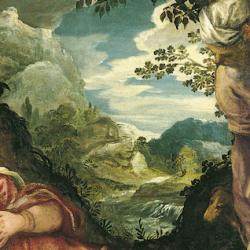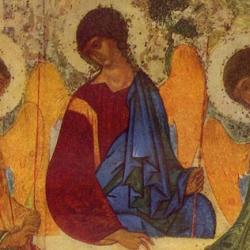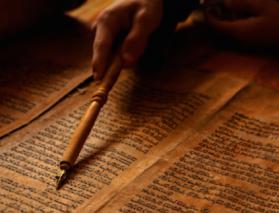Carroll’s chief argument is that the cross takes on a centrality after Constantine that it never had in earlier Christianity, which focused instead on the incarnation and resurrection.
The cross was comparatively rare in the earliest Christian iconography, but the notion that Christianity, and Christian salvation, is focused on the cross (as well as the resurrection) of Jesus, predates Constantine and the Nicene Council by a century and a half.
In his Apology , Tertullian rebutted pagan complaints about Christian devotion to the cross: “Then, if any of you think we render superstitious adoration to the cross , in that adoration he is sharer with us. If you offer homage to a piece of wood at all, it matters little what it is like when the substance is the same: it is of no consequence the form , if you have the very body of the god. And yet how far does the Athenian Pallas differ from the stock of the cross , or the Pharian Ceres as she is put up uncarved to sale, a mere rough stake and piece of shapeless wood? Every stake fixed in an upright position is a portion of the cross ; we render our adoration , if you will have it so, to a god entire and complete. We have shown before that your deities are derived from shapes modelled from the cross . But you also worship victories, for in your trophies the cross is the heart of the trophy.
In his first apology, Justin discovered a type of the cross in Plato’s Timaeus , and explicitly compared the cross to the saving serpent-pole of Numbers 21: “And the physiological discussion concerning the Son of God in the Timæus of Plato , where he says, He placed him crosswise in the universe
he borrowed in like manner from Moses ; for in the writings of Moses it is related how at that time , when the Israelites went out of Egypt and were in the wilderness, they fell in with poisonous beasts, both vipers and asps , and every kind of serpent, which slew the people; and that Moses , by the inspiration and influence of God , took brass, and made it into the figure of a cross , and set it in the holy tabernacle , and said to the people, If you look to this figure, and believe , you shall be saved thereby.
And when this was done, it is recorded that the serpents died, and it is handed down that the people thus escaped death.”
And in the Dialogue with Trypho the Jew, Justin does a riff on the various types of the cross in the Old Testament: ” Hear, then, how this Man, of whom the Scriptures declare that He will come again in glory after His crucifixion , was symbolized both by the tree of life, which was said to have been planted in paradise , and by those events which should happen to all the just . Moses was sent with a rod to effect the redemption of the people; and with this in his hands at the head of the people, he divided the sea. By this he saw the water gushing out of the rock; and when he cast a tree into the waters of Marah , which were bitter, he made them sweet. Jacob , by putting rods into the water-troughs , caused the sheep of his uncle to conceive, so that he should obtain their young. With his rod the same Jacob boasts that he had crossed the river. He said he had seen a ladder, and the Scripture has declared that God stood above it. But that this was not the Father , we have proved from the Scriptures . . . . Aaron’s rod, which blossomed, declared him to be the high priest . Isaiah prophesied that a rod would come forth from the root of Jesse, [and this was] Christ . And David says that the righteous man is ‘like the tree that is planted by the channels of waters, which should yield its fruit in its season, and whose leaf should not fade.’ Again, the righteous is said to flourish like the palm-tree . God appeared from a tree to Abraham, as it is written, near the oak in Mamre . The people found seventy willows and twelve springs after crossing the Jordan . David affirms that God comforted him with a rod and staff. Elisha , by casting a stick into the river Jordan , recovered the iron part of the axe with which the sons of the prophets had gone to cut down trees to build the house in which they wished to read and study the law and commandments of God ; even as our Christ , by being crucified on the tree, and by purifying [us] with water, has redeemed us, though plunged in the direst offences which we have committed, and has made [us] a house of prayer and adoration . Moreover, it was a rod that pointed out to be the father of Tamar’s sons by a great mystery .”
Pagan critics noticed the Christian devotion to the cross as well. In his Octavius , Minucius Felix (dates unknown, but definitely pre-Constantine) records the pagan mockery of Christians for worshiping the cross that they deserve to receive as a punishment: “And now, as wickeder things advance more fruitfully, and abandoned manners creep on day by day, those abominable shrines of an impious assembly are maturing themselves throughout the whole world. Assuredly this confederacy ought to be rooted out and execrated. They know one another by secret marks and insignia, and they love one another almost before they know one another. Everywhere also there is mingled among them a certain religion of lust, and they call one another promiscuously brothers and sisters, that even a not unusual debauchery may by the intervention of that sacred name become incestuous: it is thus that their vain and senseless superstition glories in crimes. Nor, concerning these things, would intelligent report speak of things so great and various, and requiring to be prefaced by an apology, unless truth were at the bottom of it. I hear that they adore the head of an ass, that basest of creatures, consecrated by I know not what silly persuasion,—a worthy and appropriate religion for such manners. Some say that they worship the virilia of their pontiff and priest, and adore the nature, as it were, of their common parent. I know not whether these things are false; certainly suspicion is applicable to secret and nocturnal rites; and he who explains their ceremonies by reference to a man punished by extreme suffering for his wickedness, and to the deadly wood of the cross, appropriates fitting altars for reprobate and wicked men, that they may worship what they deserve.”











